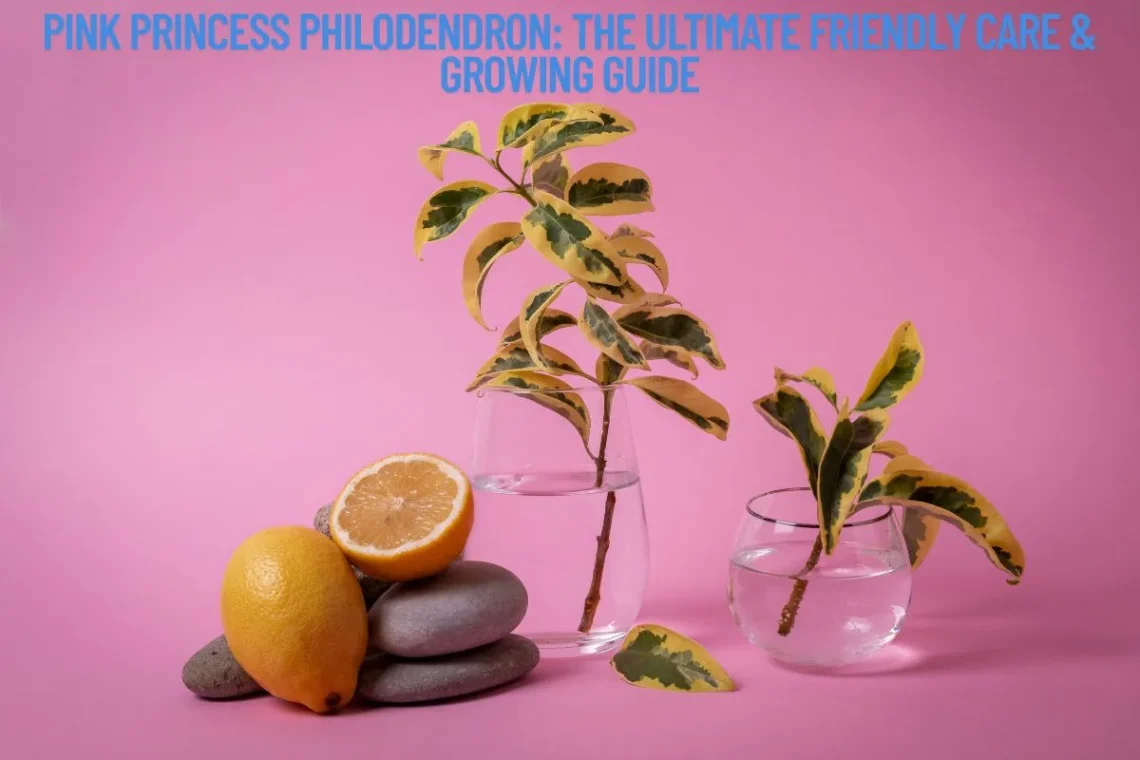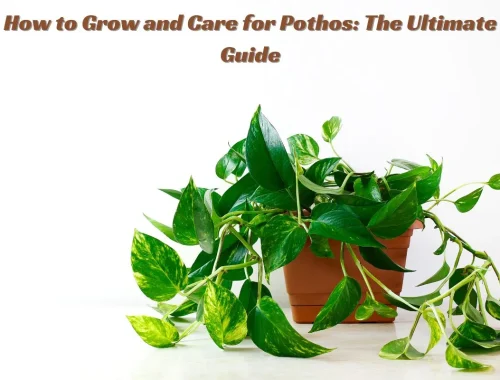
Pink Princess Philodendron: The Ultimate Friendly Care & Growing Guide
Few houseplants inspire as much excitement and “plant envy” as the Pink Princess Philodendron. With leaves that look hand-painted in pink, deep green, and sometimes even chocolate brown, this plant combines rare beauty with a unique personality. Is it as magical as the internet claims? How do you get bold pink streaks? And why does everyone—myself included—seem to want one?
This heartfelt, easy-to-follow guide gives you everything you need to know—whether you’re a collector, a beginner, or just dreaming! Expect personal stories, clear steps, expert tips, and insights written for everyone, from fifth-graders to seasoned plant fans.
Table of Contents
ToggleWhat Is a Pink Princess Philodendron?
The Pink Princess is a type of Philodendron erubescens, a species from the rainforests of Colombia. Unlike its wild relatives, the Pink Princess is famous for leaves streaked with pink. It’s a climbing aroid (meaning it likes to grow upward!) and is part of the beloved philodendron family known for easy care and dramatic leaves.
What sets it apart:
-
Pink variegation: No two leaves are ever the same!
-
Deep green base color: Sometimes nearly black, making the pink “pop.”
-
Long, pointed leaves: Elegant on shelves, desks, or hanging baskets.
Personal story: My friend Sarah got her first Pink Princess as a baby cutting. She texted me with every new leaf, especially when the first “bubblegum pink” splash appeared. There was real joy in those moments—it makes plant parenthood feel special!
Why Is Philodendron Pink Princess So Expensive?
Let’s be honest: this plant can cost more than a nice dinner out! Here’s why:
1. It’s Rare and Hard to Grow from Seed
Pink Princess is created by propagation, not from regular seeds. Each new cutting is a clone, and only some grow those perfect pink streaks.
2. Variegation Is Unpredictable
The pink color comes from random cells in the plant’s DNA. Some plants grow mostly green, others half-pink. Growers have to nurture dozens to get one “princess” with dramatic color.
3. Slow Growth
Philodendron Pink Princess is slower growing than many houseplants. Waiting months for new leaves makes each plant more valuable.
4. High Demand
The internet made Pink Princess go viral. With plant collectors around the world seeking cuttings, the price shot up.
Unique insight: Don’t be afraid to buy a smaller or less-pink starter plant. With good care (see later tips!), your own “princess” can develop better color over time, making the journey more satisfying and less expensive.
How Do You Care for a Pink Princess Philodendron?
Philodendrons are known for being low-fuss—but Pink Princess needs a little extra attention to stay healthy AND colorful.
1. Light
-
Bright, indirect sunlight is key!
-
Direct sun can scorch the pink areas (which are extra sensitive).
-
Too little light and your plant loses pink leaves and reverts to green or dark.
-
East or north windows are ideal, or a spot just out of direct rays.
Pro tip: Use a grow light if your indoor space is gloomy. I use a simple LED bulb, and it helped my Princess sprout more vibrant leaves!
2. Water
-
Allow the top 1–2 inches of soil to dry before watering.
-
Too much water = root rot; too little = leaf curls and brown edges.
Story: I overwatered mine the first winter. The leaves with the most pink faded and dropped! Now, I wait until the pot feels light and dry to the touch, and both my plant and I are happier.
3. Humidity & Temperature
-
Loves humidity (above 50%). Bathrooms or kitchens are great.
-
Use a tray of water, a humidifier, or group with other plants.
-
Keep above 16°C (60°F). No cold drafts!
4. Soil & Repotting
-
Use a chunky, well-draining mix: potting soil plus perlite and orchid bark.
-
Repot every 1–2 years or when roots poke out.
-
Always choose a pot with drainage holes.
5. Feeding
-
Feed monthly during the growing season (spring–summer) with a gentle liquid fertilizer.
-
Avoid overfeeding; too much can cause weird leaf shapes or color loss.
6. Cleaning
-
Dust can dull its gorgeous shine—wipe leaves gently every few weeks with a damp, soft cloth.
How to Make a Pink Princess Philodendron More Pink
This is the golden question for every collector. The secret is encouraging the right environment for vivid variegation (the pink parts):
1. MAXIMIZE Bright, Indirect Light
-
More light equals more pink—without burning the delicate leaves.
-
Place the plant near the brightest window without direct hot sun.
-
Rotate the pot monthly so all sides get equal light.
2. Prune Strategically
-
If new leaves are ALL green or ALL pink for several in a row, prune below the latest plain-colored leaf.
-
This encourages the plant to grow a new shoot with a potential mix of pink and green.
-
Never prune ALL the pink—full pink leaves have no chlorophyll and can’t feed the plant on their own!
Personal note: I once let my plant grow several fully pink leaves in a row. They were beautiful, but quickly died. Learned to keep a balance for a healthy, happy Princess!
3. Fertilize, But Don’t Overdo
-
Balanced fertilizer supports healthy growth and color.
-
Too little feeds = slower growth and dull green; too much can cause “burned” variegation.
4. Give It Space
-
Crowded roots or leaves can lead to less vibrant color, so let your pink princess spread out!
Is Philodendron Pink Princess a Climber?
Yes, it is! In the wild, this plant climbs trees using strong, trailing stems.
How to Encourage Climbing (“Vining”)
-
Give it a moss pole, bamboo stake, or trellis to latch onto.
-
Tie stems gently to supports with soft ties or string.
-
Climbing encourages larger, healthier, and more vibrantly colored leaves.
Unique insight: When my plant finally grabbed onto a moss pole, the leaves doubled in size and developed pink patches that were so vivid, friends who’d only seen pics on Instagram thought it was fake!
Troubleshooting: Why Does My Pink Princess Look Sad?
Leaf edges turning brown?
-
Underwatering, low humidity, or too much sun.
Leaves looking dull or losing pink?
-
Not enough light or nutrients.
Leggy, stretched-out stems?
-
More light is needed. Move closer to a window or add a grow light.
Leaves with only pink or only green?
-
Prune just below the bland leaf to encourage more mixed color.
Personal anecdote: My biggest mistake was putting my Princess on top of a bookshelf, out of sight and out of the sun—its pink quickly faded. Lesson learned: these plants WANT to shine where you can see them!
Quick Q&A for Pink Princess Parents
Why is Philodendron Pink Princess so Expensive?
It’s rare, slow to grow, and pink variegation is unpredictable—plus lots of people want one!
How Do You Care for a Pink Princess Philodendron?
Bright, indirect light; let soil dry slightly between waters; high humidity; occasional feeding; give it something to climb on; clean leaves gently.
How to Make It More Pink?
Maximize light exposure, prune for variegation, avoid drastic temperature or water changes, and stay patient!
Is It a Climber?
Yes, Pink Princess loves to climb! Give it a pole or trellis for bigger, showier leaves.
Unique Insights & Bonus Tips
-
Pink Princesses love positive attention: Talk to them. Move it so you can enjoy its colors. The more you interact, the better you’ll notice changes and give it what it needs (plus, it’s fun).
-
Don’t panic if a new leaf is less pink: Variegation is genetic and can change over time—usually for the better with TLC.
-
Leaf shape drama: New growth may be small, oddly shaped, or crumpled—don’t worry; it usually straightens out as the plant matures.
-
Sharing the love: Pink Princesses can be propagated from stem cuttings—great for sharing with friends (or selling to cover your plant-collecting “habit” as a friend of mine jokes).
Table: Pink Princess Philodendron At a Glance
| Feature | Details |
|---|---|
| Light | Bright, indirect (no hot sun) |
| Water | When top 1–2″ soil dry, drain well |
| Humidity | High (50%+) |
| Soil | Chunky, well draining (potting mix + perlite, orchid bark) |
| Fertilizer | Light, spring–summer only |
| Growth habit | Climber/vine |
| Toxicity | Yes, mildly to pets/humans if eaten |
| Pink boosting tip | More light + strategic pruning |
Final Thoughts: Why Pink Princess Is an Indoor Superstar
The Pink Princess Philodendron isn’t just a trend—it’s a long-lasting, ever-changing plant that turns a shelf, desk, or window into a tropical art gallery. Its splashes of pink make every new leaf a surprise. With patience, love, and the tips from this guide, you’ll soon be an expert “pink parent.”
The first time I saw a leaf unfurl, bright with streaks of pink, I felt a bit of magic. That’s what makes Pink Princess such a cherished plant—every bit of color feels like a personal win!
If you’re dreaming of your own Pink Princess, or caring for one already, remember: don’t stress about perfection. The journey—with all those surprising pinks and lush greens—is the best part of all.
Happy growing, and may your leaves be ever bright and pink!
You May Also Like

How to Grow and Care for Pothos: The Ultimate Guide
June 30, 2025
How to Handle a Flooded Kitchen Floor Like a Pro
September 10, 2025

